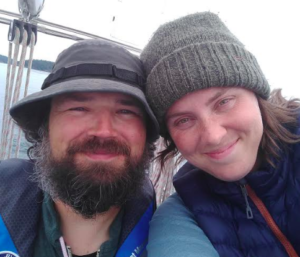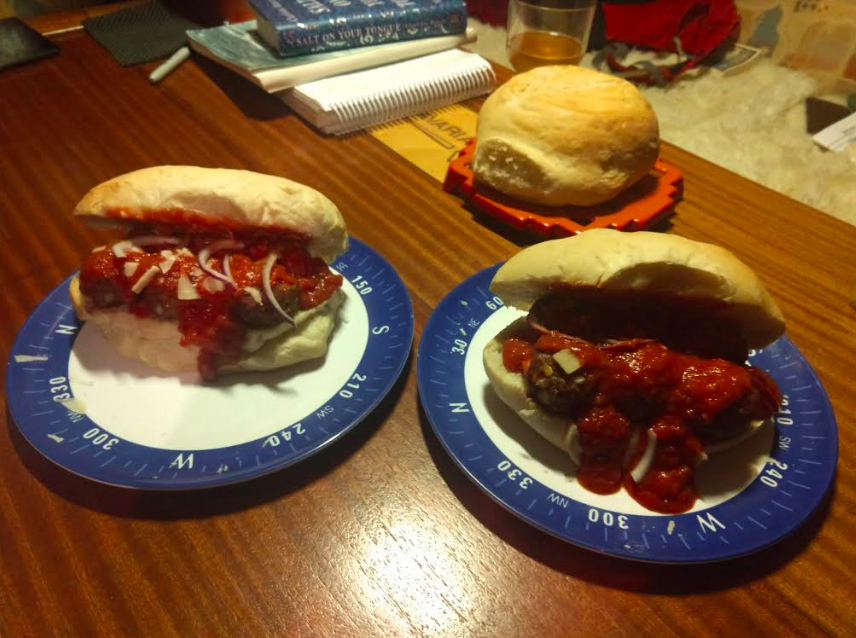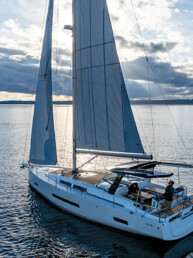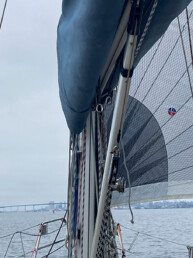In our latest Throwback Thursday, longtime 48° North columnist Amanda Swan checks in with Friday Harbor liveaboard Margot McKirdy to see what secrets her galley holds.
I recently met Margot McKirdy here in Friday Harbor, and not only was I delighted to discover that’s she a fellow swimmer but she’s also a liveaboard. In the following interview Margot shares her galley set up and reveals how a stormy anchorage on the west coast of Vancouver Island kick-started her newly found passion for making sourdough bread.
How did you get into the cruising life?
Our boat is a 2000 Bavaria Ocean 38 center cockpit called Favignana. Elliot and I named our boat after the place where we first had the idea/dream to live and travel by boat. Early in our relationship we travelled to Favignana; a small island off the west coast of Sicily where the surrounding waters were dotted with sailboats. We thought “now that’s the way to travel” so decided to take a break from full-time work to embark on a sailing adventure.
had the idea/dream to live and travel by boat. Early in our relationship we travelled to Favignana; a small island off the west coast of Sicily where the surrounding waters were dotted with sailboats. We thought “now that’s the way to travel” so decided to take a break from full-time work to embark on a sailing adventure.
I’m an avid open water swimmer and spend most of my free time in the water. My best self is around water and I’ve always felt a huge sense of joy and freedom when on a boat. It was Elliot’s idea to transition aboard but it was easy to get excited about it and the infinite swimming opportunities it creates. By all accounts we consider ourselves newbies. We took a weeklong learn-to-sail course through San Juan Sailing with some experienced friends of Elliot’s and we’re continuing to seek out new opportunities to learn both on our own and from others. Last summer we circumnavigated Vancouver Island and we’re now planning to leave the Pacific Northwest next summer for Mexico and the beginning of an open-ended period of world travel.
Do you get seasick?
Yes. Every time I mention nausea to anyone, I get the comment, “have you tried ginger?” Yes, I have, so many times over the years, that now the smell of ginger almost brings on the nausea. The little wristbands with the acupressure balls never cut it for me but I do own a pair to trick my brain and look super fashionable. Besides Bonine over the counter seasickness medication, and prescription Zofran, I’ve had the most success sucking on hard sour candies, and if at all possible staying above deck.
What is your galley layout?
We have a walk-through galley on the port side with double sinks, the original two burner stove/oven and a top-loader fridge with a mind of its own that we’re desperately trying to control and no freezer.
What are your galley priorities?
I like to keep the surfaces clean and clutter free, which is easier when underway as once docked these precious horizontal spaces tend to clutter. My must-have galley item is our cast iron pan and runner up is the Dutch-oven for bread making.
For our Vancouver Island trip we stocked up on meats that were cured in some way, smoked salmon, and items with a shelf life of more than three weeks. I discovered I like all the phases of the provisioning cycle. When we stumbled upon an actual grocery store or well stocked marina shop, we’d spend the next few days creating elaborate brunches and dinners. But some of our most memorable meals actually came from the days when everything seemed to be running low.
What is your comfort food?
We both agree it’s rice and beans. Maybe that’s why we’re together. Our latest galley addition, which seems very promising, is a heat diffuser for the stove top. I inaugurated it the other day and the results were the fluffiest rice we’ve had since moving aboard and away from our rice cooker that Elliot dearly misses.
What are your favorite meals?
Underway we rely on tortillas to transform any food into an edible-with-one-hand burrito. We make breakfast burritos and also enjoy dinner leftovers in a wrap. Frittatas are also wonderful to make underway and are great to eat at any temperature. I get a few of the ingredients going on the stovetop in the cast iron, maybe smoked salmon, onions and garlic, then add some eggs and pop it in the oven. I can then go back on deck while it finishes cooking. When we’re lazy we survive on PBJ wraps and tuna salad with saltines. Curry and rice is a favorite, here’s my recipe.
CURRY AND RICE
Prepare rice for four
4 chicken thighs, or pork or beef, or totally wonderful without meat
3 onions – chopped
4 cups of chopped vegetables of your choice
1½ cups coconut milk, chicken broth or vegetable broth
3 cloves garlic – chopped
2-inch piece ginger – chopped
curry powder to taste (recipe below)
4 tablespoons butter
cilantro – chopped
pineapple – chopped
Cook rice according to directions. Meanwhile using a mortar and pestle mash curry powder with garlic, ginger and 1 tablespoon butter. Heat a skillet over medium/high heat add remaining butter, onion and chicken thighs, skin side down, to brown the skin for 2 minutes. Turn heat down, add vegetables and curry, cover with a lid. Stir occasionally and when nearly cooked add coconut milk and bring to a simmer. Serve with rice and garnish with cilantro and pineapple.
CURRY POWDER
1 teaspoon turmeric
1 teaspoon coriander
1 teaspoon cumin
1 teaspoon cardamom
chili or cayenne to taste
1 teaspoon pepper
2 teaspoons salt
Has your diet changes since you started your sailing adventures?
There are certain foods we eat more of because of the ease of cooking them such as polenta, which has become our best friend. it’s ready so quickly and tastes so good for every meal. Before moving aboard we’d stumble onto a polenta meal occasionally, and even buy pre-cooked polenta logs. I now prefer a rougher cut cornmeal for the texture, but cheaper fine grain works just as well.
POLENTA
1 cup of cornmeal
3 cups of water
butter and salt to taste.
Get the water boiling, while whisking slowly add cornmeal to avoid it clumping, turn heat down to low and stir occasionally until thick, about 5 minutes. For breakfast serve with bacon and onions and vegetables. For dinner serve with vegetables, steak or salmon.
Have you had a disaster food moment?
On the west coast of Vancouver Island we were excited to find a tiny rundown fuel dock because we were running low on food. Elliot started fueling and I went inside the store. Some of the items looked like they’d been there for at least a couple of years, so I was debating whether to get some onions and ham. At that moment, Elliot, who was just finishing the fueling, accidentally stepped on the paw of the fuel dock owner’s dog. The dog then promptly turned around and bit him in the butt and the owners quickly totaled us up for the fuel, plus the onions and ham and we smartly got underway. Later when I went to make lunch, I discovered the ham was moldy and the onions were rotten. It was easy to laugh it off as we felt like the fuel dock couple probably needed the business.
What are your most memorable meals from your sailing travels?
We docked at Zeballos in a light rain and even though the town seemed empty, the blackberry bushes were full so I collected a couple bowls of them. After listening to the weather report, we decided to make it a long day and round Estevan point before the predicted high southeast winds arrived. We ended up setting the anchor around 6 p.m. in Hot Springs Cove. I made a blackberry cobbler and let it cool while we hiked the well-travelled trail of wooden planks engraved with boat names and dates to enjoy the hot springs at sunset. It was the perfect time of day as the crazy charter boats and planes had left but not necessarily the most ideal tide time for soaking as the tide was low. Back at the boat I took an amazing nighttime dip with bioluminescence then went below to enjoy the still warm cobbler.
BLACKBERRY COBBLER
5 cups blackberries – rinsed and drained
½ cup white sugar
½ cup brown sugar
juice of one lemon juice
1 egg
1 cup flour
1 stick of butter – diced small
Preheat oven to *ON*. Place berries in baking dish and toss with lemon juice and half the white sugar. Mix together egg, remaining sugars and flour and pour over berries then scatter with butter. Bake 30-40 minutes until top is golden and berries are bubbling and smelling amazing. Let stand a while, ideally the time it takes to enjoy a hike and soak in the hot springs. We enjoyed it without any toppings but I’ m sure it would be delicious with whipped cream or ice cream, things we don’t keep on our boat, but maybe you do on yours.
*Our oven doesn’t appear to have much of a temperature difference as everything bakes at ON. When the door is closed, I believe it gets to 350°F at the hottest but when the door opens, which is unavoidable when you place in items, the temperature quickly drops.
What local specialty foods have you made aboard?
I don’t know about local specialty foods, but I got on a wild-yeast bread making kick halfway around Vancouver Island. After making some successful instant yeast breads I felt it would be tasty and poetic to harness the wild yeasts around us and make sourdough.
I started with a yeast that I named “Stormy” because I brought it into being while at anchor for a couple of stormy days. I liked the idea of making bread that was, at its core, a product of the place we were in—no, I didn’t take to harvesting the local plant grains and grinding them into a flour. It was magical to be making bread from the yeasts in the air around us. I fed my starter daily and placed it under the glass dodger to allow it to continue to develop. I got a little obsessive and found myself making more bread than we could eat.

I tried using sourdough starter to make pancakes, used old bread for French toast and ground it into breadcrumbs to coat chicken breasts. I realized it was getting out of control when I had three starters on the go. I’ve now pared it back down to one that I refrigerate at times so I don’t feel compelled to make bread all the time. I’m not sure that maintaining a sourdough starter is a great idea on a boat, but in the absence of plants or pets to care for it keeps me busy.
At the height of my bread making (see below) we decided to make sandwich rolls. These had a bigger rise than I was anticipating so they ended up being gigantic. We made meatballs, which we’ve made a lot of since they’re very forgiving about oven temperature. On this day we used canned pasta sauce as we didn’t have the fresh ingredients and after making bread and meatballs from scratch we also didn’t have the endurance to make our own sauce.
SOURDOUGH STARTER BREAD
There’s plenty to tell you about bread making so if you want to make boat bread I suggest you find a recipe in a respected cookbook and experiment with it. In my research for bread recipes, particularly sourdough, I’ve come across a lot of conflicting opinions and many of the techniques are unrealistic in a boat oven. The first couple of times I made bread I used the recipe from my favorite cookbook How to Cook Everything by Mark Bittman. But very quickly I was experimenting with all kinds of adaptations so it would be impossible to recall exactly what recipe I used the night of the meatballs. I’ve found satisfaction in eyeballing quantities and making decisions based on how the dough feels, and it doesn’t bother me that my recipes are not reproducible. It’s rewarding that each loaf is different and unique and even if it’s not perfect it is usually edible and delicious, especially with butter and (in my opinion) apricot jam.
one healthy scoop (½-1 cup) of sourdough starter
3½ cups all-purpose white flour –
2 cups water
large pinch salt
When I feed my starter I take half of it out and either use it or dump it. On a day when I feel like using my sourdough starter, I place a heathy scoop in a bowl and I feed both starters ½ cup of flour ⅜ cup of water. I stir the starter in the jar well before placing it away. I stir the starter/flour/water in the bowl well and set it in a warm location; outside on a warm day or near a heat source on a cooler day (heater vent, near the oven, or engine) covered in a clean towel.
After a couple hours the yeast is bubbling, and the mixture is doubled in size with the consistency of marshmallow fluff when stirred. By hand I mix in 1½ cups flour and ½ cup water then slowly mix in up to 1½ cups flour until a defined ball of dough is formed. It should be a little sticky and come away clean from the sides of the bowl. The amount of flour depends on how wet the starter is. If there’s too much flour I add a little more water. When I’m happy with my shaggy dough ball, I leave it in the bowl, covered, in a warm place for several hours or overnight.
I then reshape the ball into a boule, tucking the bottom edges in and creating some surface tension on the top. I place the boule in either an oiled Dutch oven or on a baking sheet and cover again, letting it rise for 2-6 hours. After preheating the as hot as it will go add a pan with a little water in it to help create steam and disperse the heat evenly (the Dutch oven also helps create steam and disperse heat) then add the bread. When the bread smells good and the crust is golden brown it’s done. The internal temperature of the bread should be about 210F and it will sound hollow when you knock the bottom.

MEATBALL SUBS
1½ lbs ground meat – beef, pork, lamb, or any combo
½ cup breadcrumbs – old stale bread or panko
1 egg – lightly beaten
1 onion – diced
1 bell pepper – diced
spices – I use whatever I feel like on that day and I’ve yet to get it wrong
Preheat oven to 425°F (if possible). In a bowl, mix ingredients together then form into balls with your hands. Heat a skillet to high and brown meatballs. Place meatballs on a cookie sheet and bake cook until done, about 15 minutes. Serve on fresh baked bread rolls with marinara sauce and grated cheese.
Amanda Swan
Amanda Swan is a sailor and former 48° North columnist. She currently resides in New Zealand and is the author of "Diesel Engine Essentials - A Learning and Coloring Book" and "The Essential Galley Companion."






